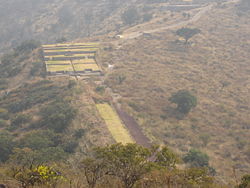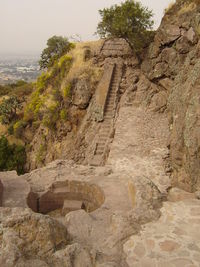Texcotzingo
 | |
| Location | Oaxtepec |
|---|---|
| Coordinates | 19°29′49″N 98°49′06″W / 19.49694°N 98.81833°W |
| History | |
| Builder | Nezahualcoyotl |
Texcotzingo (alternatively, Tetzcotzingo) is claimed to be one of the first extant botanical gardens in the Americas, along with Moctezuma's gardens in Huastepec. The gardens and archaeological site are located roughly 20 miles northeast of central Mexico City, Mexico.
Texcotzingo is adjacent to the Aztec capital city of

History

Texcotzingo was designed and created by
New hydraulic projects and terrace gardens transformed the previously un-arable land into lush edible gardens containing the three ubiquitous staples of the Americas:
Aesthetic manifestations of practiced myths, vital to Aztec culture, also occupied an important place at Texcotzingo, with spaces designed for the performance of poetry, singing, dancing and oration. This transformation of the mountain of Texcotzingo into art, and the perception that the mountain itself was art, in that it held special significance (mythical or otherwise) in pre-Columbian culture, classifies Texcotzingo as an earthwork. There is also a tangible connection between the ideas of art, culture and nature manifested in rocks and sculptures, existing flora and plantings, etc. in the design of Texcotzingo.
Notes
- ^ Avilés (2006)
References
- Avilés, Paul (2006). "Seven Ways of Looking at a Mountain: Tetzcotzingo and the Aztec Garden Tradition". Landscape Journal. 25 (2). Madison: OCLC 7534225.
- Granziera, Patrizia (Winter 2001). "Concept of the garden in pre-Hispanic Mexico". Garden History. 29 (2). London: Garden History Society (Great Britain): 185–213. OCLC 199661938.

